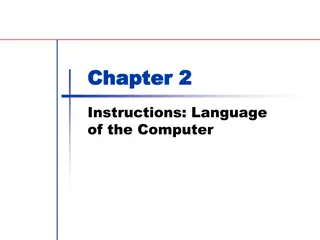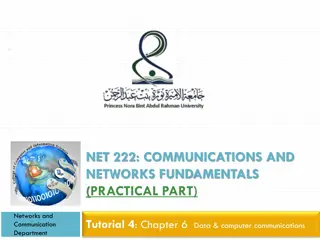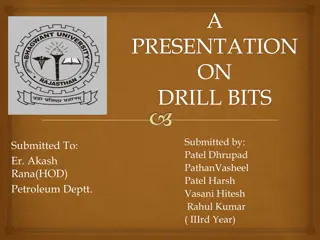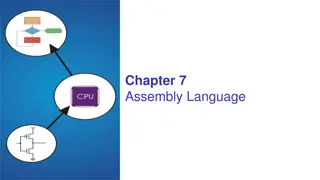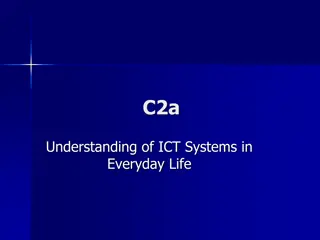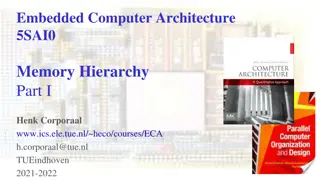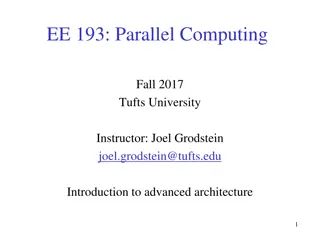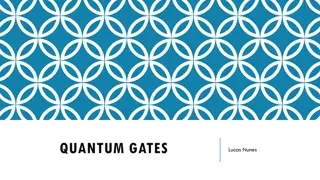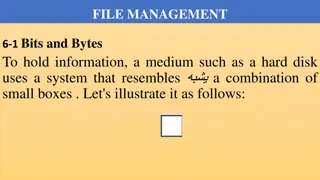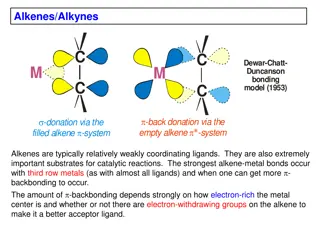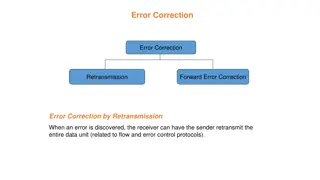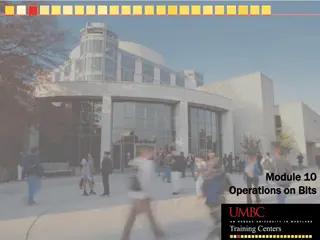The Language of Bits in Computer Architecture
Dive into the world of bits in computer architecture with this insightful PowerPoint presentation by Prof. Smruti Ranjan Sarangi. Explore topics such as Boolean algebra, logical operations, and more. Understand how computers communicate through the language of 0s and 1s, and discover the fundamental operations that govern digital systems. Enhance your knowledge of binary data representation and master the core concepts of basic computer architecture.
Download Presentation

Please find below an Image/Link to download the presentation.
The content on the website is provided AS IS for your information and personal use only. It may not be sold, licensed, or shared on other websites without obtaining consent from the author.If you encounter any issues during the download, it is possible that the publisher has removed the file from their server.
You are allowed to download the files provided on this website for personal or commercial use, subject to the condition that they are used lawfully. All files are the property of their respective owners.
The content on the website is provided AS IS for your information and personal use only. It may not be sold, licensed, or shared on other websites without obtaining consent from the author.
E N D
Presentation Transcript
PowerPoint Slides The Language of Bits Basic Computer Architecture Prof. Smruti Ranjan Sarangi IIT Delhi Chapter 2: The Language of Bits 1
2nd version www.basiccomparch.com Download the pdf of the book videos Slides, software, solution manual Print version (Publisher: WhiteFalcon, 2021) Available on e-commerce sites. The pdf version of the book and all the learning resources can be freely downloaded from the website: www.basiccomparch.com
Outline Boolean Algebra Positive Integers Negative Integers Floating-Point Numbers Strings 3
What does a Computer Understand ? Computers do not understand natural human languages, nor programming languages They only understand the language of bits 0 or 1 0 or 1 0 or 1 0 or 1 Bit Bit 0 or 1 0 or 1 0 or 1 8 bits Byte 0 or 1 0 or 1 0 or 1 4 bytes Word 0 or 1 0 or 1 0 or 1 1024 bytes kiloByte 0 or 1 0 or 1 106 bytes megaByte 4 4
Review of Logical Operations A + B (A or B) A B A + B 0 0 0 1 0 1 0 1 1 1 1 1 A B A.B A.B ( A and B) 0 0 0 1 0 0 0 1 0 1 1 1 5
Review of Logical Operations - II A B A NOR B A B A NAND B 0 0 1 0 0 1 1 0 0 1 0 1 0 1 0 0 1 1 1 1 0 1 1 0 NAND and NOR operations These are universal operations. They can be used to implement any Boolean function. 6
Review of Logical Operations XOR Operation : (A B) A B A XOR B 0 0 0 1 0 1 0 1 1 1 1 0 7
Review of Logical Operations NOT operator Definition: 0 = 1, and 1 = 0 Double negation: A = A, NOT of (NOT of A) is equal to A itself OR and AND operators Identity: A + 0 = A, and A.1 = A Annulment: A + 1 = 1, A.0 = 0 8
Idempotence: A + A = A, A.A = A, The result of computing the OR and AND of A with itself is A. Complementarity: A + A = 1, A.A = 0 Commutativity: A + B = B + A, A.B = B.A, the order of Boolean variables does not matter Associativity: A+(B+C) = (A+B)+C, A.(B.C) = (A.B).C, similar to addition and multiplication. Distributivity: A.(B + C) = A.B + A.C, A+ (B.C) = (A+B). (A+C) Use this law to open up parantheses and simplify expressions
De Morgan's Laws Two very useful rules A + B = A.B A.B = A + B 10
Consensus Theorem Prove : X.Y + X.Z + Y.Z = X.Y + X.Z 11
Outline Boolean Algebra Positive Integers Negative Integers Floating Point Numbers Strings 12
Representing Positive Integers Ancient Roman System Symbol I V X L C D M Value 1 5 10 50 100 500 1000 Issues : There was no notion of 0 Very difficult to represent large numbers Addition, and subtraction (very difficult) 13
Indian System Bakshali numerals, 7th century AD Uses the place value system 5301 = 5 * 103 + 3 * 102 + 0 * 101 + 1*100 Example in base 10 14
Number Systems in Other Bases Why do we use base 10 ? because ... 15
What if we had a world in which ... People had only two fingers. 16
Binary Number System They would use a number system with base 2. Number in decimal Number in binary 101 1100100 111110100 10000000000 5 100 500 1024 17
MSB and LSB MSB (Most Significant Bit) The leftmost bit of a binary number. E.g., MSB of 1110 is 1 LSB (Least Significant Bit) The rightmost bit of a binary number. E.g., LSB of 1110 is 0 18
Hexadecimal and Octal Numbers Hexadecimal numbers Base 16 numbers 0,1,2,3,4,5,6,7,8,9,A,B,C,D,E,F Start with 0x Octal Numbers Base 8 numbers 0,1,2,3,4,5,6,7 Start with 0 19
Examples Convert 110010111 to the octal format : 110 010 111 = 0627 Convert 111000101111 to the hex format : 111000101111 = 0xE2F
Outline Boolean Algebra Positive Integers Negative Integers Floating Point Numbers Strings 21
Representing Negative Integers Problem Assign a binary representation to a negative integer Consider a negative integer, S Let its binary representation be : xnxn-1 .x2x1 (xi=0/1) We can also expand it to represent an unsigned, +ve, number, N If we interpret the binary sequence as : An unsigned number, we get N A signed number, we get S 22
We need a mapping : F : S N (mapping function) S set of numbers (both positive and negative signed) N set of positive numbers (unsigned) mapping Set of Set of +ve numbers +ve and -ve numbers 23
Properties of the Mapping Function Preferably, needs to be a one to one mapping All the entries in the set, S, need to be mapped It should be easy to perform addition and subtraction operations on the representation of signed numbers Assume an n bit number system SgnBit(u) = 1 , u < 0 0 , u >= 0 24
Sign-Magnitude Base Representation = n+ 1 ( ) ( * ) u 2 | | F u SgnBit u sign bit |u| Examples : -5 in a 4 bit number system : 1101 5 in a 4 bit number system : 0101 -3 in a 4 bit number system : 1011 25
Problems There are two representations for 0 000000 100000 Addition and subtraction are difficult The most important takeaway point : Notion of the sign bit 26
1's Complement Representation 1 , 0 u u = ( ) F u n ~ (| |) 2 ( | |), 0 u or u u Examples in a 4 bit number system 3 0011 -3 1100 5 0101 -5 1010 27
Problems Two representations for 0 0000000 1111111 Easy to add +ve numbers Hard to add -ve numbers Point to note : The idea of a complement 28
Bias Based Approach F(u)=u+bias Consider a 4 bit number system with bias equal to 7 -3 0100 3 1010 F(u+v) = F(u) + F(v) bias Multiplication is difficult 29
The Number Circle 0000 (0) 1111 (15) 0001 (1) 1110 (14) 0010 (2) 1101 (13) 0011 (3) Increment 0100 (4) 1100 (12) 0101 (5) 1011 (11) 0110 (6) 1010 (10) 0111 (7) 1001 (9) 1000 (8) Clockwise: increment Anti-clockwise: decrement 30
Number Circle with Negative Numbers 0000 (0) 1111 (-1) 0001 (1) 1110 (-2) 0010 (2) 1101 (-3) 0011 (3) Increment 0100 (4) 1100 (-4) 0101 (5) 1011 (-5) 0110 (6) 1010 (-6) 0111 (7) 1001 (-7) 1000 (-8) break point 31
Using the Number Circle To add M to a number, N locate N on the number circle If M is +ve Move M steps clockwise If M is -ve Move M steps anti-clockwise, or 2n M steps clockwise If we cross the break-point We have an overflow The number is too large/ too small to be represented 32
2's Complement Notation u,0 u 2n-1-1 2n-|u|,-2n-1 u<0 F(u)= F(u) is the index of a point on the number circle. It varies from 0 to 2n - 1 Examples 4 0100 -4 1100 5 0101 -3 1101 33
Properties of the 2's Complement Notation Range of the number system : -2(n-1) to 2n-1 1 There is a unique representation for 0 000000 msb of F(u) is equal to SgnBit(u) Refer to the number circle For a +ve number, F(u) < 2(n-1). MSB = 0 For a -ve number, F(u) >= 2(n-1). MSB = 1 34
Properties - II Every number in the range [-2(n-1),2(n-1) 1] Has a unique mapping Unique point in the number circle a b (a = b mod 2n) means same point on the number circle F(-u) 2n F(u) Moving F(u) steps counter clock wise is the same as moving 2n F(u) steps clockwise from 0 35
Prove : F(u+v) F(u) + F(v) Start at point u Its index is F(u) If v is +ve, move v points clockwise. We arrive at F(u+v). Its index is equal to (F(u) + v) mod 2n. Since v = F(v), we have F(u+v) = ( F(u) + F(v) ) mod 2n 36
Prove : F(u+v) F(u) + F(v) If v is -ve, move |v| points anti-clockwise. Same as moving 2n |v| points clockwise. We arrive at F(u+v). F(v) = 2n -|v| The index F(u+v) is equal to: (F(u) + 2n |v|) mod 2n= (F(u) + F(v)) mod 2n 37
Subtraction F(u-v) F(u) + F(-v) F(u) + 2n - F(v) Subtraction is the same as addition Compute the 2's complement of F(v) 38
Prove that : Prove that : F(u*v) F(u) * F(v) 39
Computing the 2's Complement 2n u = 2n 1 - u + 1 = ~u + 1 ~u (1's complement) 1's complement of 0100 2's complement of 0100 1011 1111 0001 0100 1100 1011 40
Sign Extension Convert a n bit number to a m bit 2's complement number (m > n) +ve Add (m-n) 0s in the msb positions Example, convert 0100 to 8 bits 0000 0100 -ve F(u) = 2n |u| (n bit number) system Need to calculate F'(u) = 2m -|u| 41
Sign Extension - II 2m u (2n u) = 2m 2n = 2n+ 2(n+1)+ + 2(m-1) = 11110000 m-n n F'(u) = F(u) + 2m 2n 42
Sign Extension - III To convert a negative number : Add (m-n) 1s in the msb positions In both cases, extend the sign bit by : (m-n) positions 43
The Overflow Theorem Add : u + v If uv < 0, there will never be an overflow Let us go back to the number circle There is an overflow only when we cross the break-point If uv = 0, one of the numbers is 0 (no overflow) If uv > 0, an overflow is possible 44
Number Circle: uv < 0 0 -1 1 -2 2 u=1 v=-4 -3 3 -4 45
Number Circle: uv > 0 0 -1 1 -2 2 u=1 v=3 -3 3 -4 overflow 46
Conditions for an Overflow uv <= 0 Never uv > 0 ( u and v have the same sign) The sign of the result is different from the sign of u 47
Outline Boolean Algebra Positive Integers Negative Integers Floating-Point Numbers Strings 48
Floating-Point Numbers What is a floating-point number ? 2.356 1.3e-10 -2.3e+5 What is a fixed-point number ? Number of digits after the decimal point is fixed 3.29, -1.83 49
Generic Form for Positive Numbers Generic form of a number in base 10 n 10i A= xi i=-n Example : 3.29 = 3 * 100 + 2*10-1 + 9*10-2 50
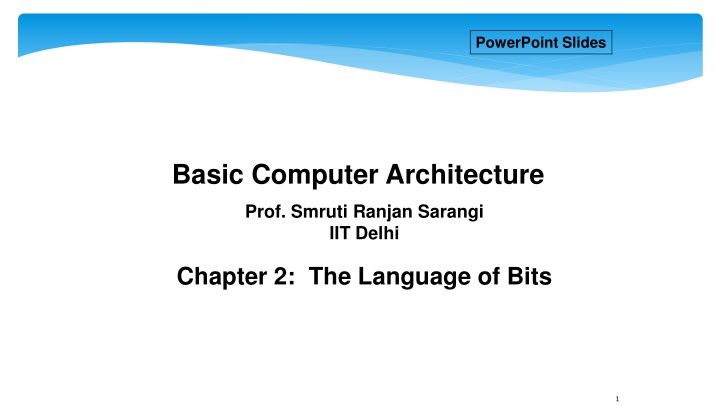

![❤Book⚡[PDF]✔ The Apollo Guidance Computer: Architecture and Operation (Springer](/thumb/21611/book-pdf-the-apollo-guidance-computer-architecture-and-operation-springer.jpg)




